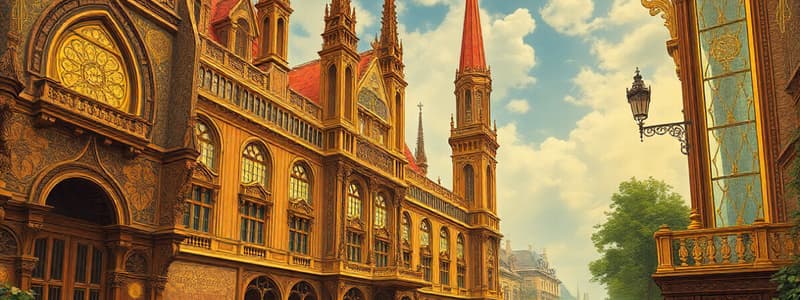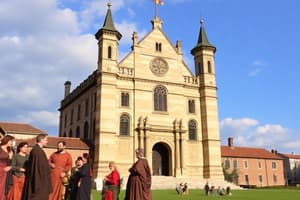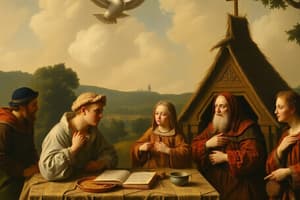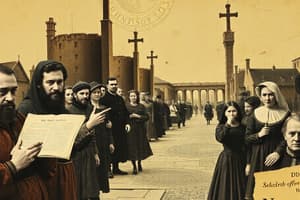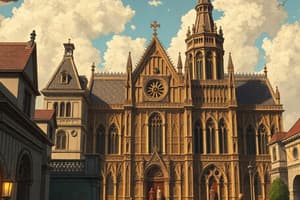Podcast
Questions and Answers
Assess the ramifications of the Italian city-states' fragmentation on Renaissance intellectual movements relative to centralized monarchies.
Assess the ramifications of the Italian city-states' fragmentation on Renaissance intellectual movements relative to centralized monarchies.
- The political structure had negligible effect; intellectual movements were solely determined by the availability of classical texts.
- Both types of political structures were equally disadvantageous as their influence obstructed authentic creativity.
- Centralized monarchies, with their unified political and economic systems, provided more stable patronage, leading to more coherent intellectual movements.
- Fragmented city-states fostered intellectual competition and innovation more effectively than centralized monarchies due to decentralized patronage. (correct)
In the context of Renaissance humanism, how did the rediscovery of classical texts challenge and reshape existing medieval scholastic traditions?
In the context of Renaissance humanism, how did the rediscovery of classical texts challenge and reshape existing medieval scholastic traditions?
- By replacing rigid, theocentric doctrines with an anthropocentric focus, fostering critical inquiry and the celebration of human potential. (correct)
- By merely supplementing scholasticism with anecdotal classical references without altering core methodologies.
- By increasing the emphasis on rote memorization of classical texts.
- By affirming existing scholastic methods by finding more primary sources.
Analyze the nuanced divergence in artistic patronage between the Church and wealthy families during the Renaissance, focusing on motivations and resulting artworks.
Analyze the nuanced divergence in artistic patronage between the Church and wealthy families during the Renaissance, focusing on motivations and resulting artworks.
- Church patronage focused exclusively on religious art to reinforce Catholic doctrine, while family patronage emphasized secular themes and portraiture for personal glorification.
- Both the Church and families sought primarily to glorify themselves, with the Church subtly incorporating subtle self-promotional elements into religious commissions. (correct)
- Wealthy families focused purely on architectural patronage, while the church focused on artistic commissions.
- Both pursued art based purely on aesthetic appeal irrespective of religious or personal undertones.
How did the bubonic plague indirectly contribute to the economic conditions favorable to the Renaissance in Italian city-states?
How did the bubonic plague indirectly contribute to the economic conditions favorable to the Renaissance in Italian city-states?
How did the political structure and mercantile nature of Italian city-states uniquely foster the elevation of individual merit during the Renaissance?
How did the political structure and mercantile nature of Italian city-states uniquely foster the elevation of individual merit during the Renaissance?
How did Renaissance humanism, with its focus on classical values, influence educational reforms during the period, and what specific subjects gained prominence as a result?
How did Renaissance humanism, with its focus on classical values, influence educational reforms during the period, and what specific subjects gained prominence as a result?
What distinguishes the artistic techniques employed by Renaissance painters such as Leonardo da Vinci and Raphael from those used by their medieval predecessors?
What distinguishes the artistic techniques employed by Renaissance painters such as Leonardo da Vinci and Raphael from those used by their medieval predecessors?
Analyze the implications of Machiavelli's political philosophy, particularly his advocacy for pragmatic leadership, on the prevailing ethical and moral standards of Renaissance society?
Analyze the implications of Machiavelli's political philosophy, particularly his advocacy for pragmatic leadership, on the prevailing ethical and moral standards of Renaissance society?
How did the ideal of the 'Renaissance man' impact the social expectations and cultural norms of the European elite during the 15th and 16th centuries?
How did the ideal of the 'Renaissance man' impact the social expectations and cultural norms of the European elite during the 15th and 16th centuries?
How did the advent of the printing press and movable type alter the dissemination of information and contribute to the intellectual ferment of during this time?
How did the advent of the printing press and movable type alter the dissemination of information and contribute to the intellectual ferment of during this time?
How did Northern Renaissance humanists differ from their Italian counterparts in their approach to classical learning and reform?
How did Northern Renaissance humanists differ from their Italian counterparts in their approach to classical learning and reform?
What impact did the rise of wealthy merchant families in Flanders have on the development of Northern Renaissance art, particularly in contrast to state-sponsored art in Italy?
What impact did the rise of wealthy merchant families in Flanders have on the development of Northern Renaissance art, particularly in contrast to state-sponsored art in Italy?
Analyze the socio-economic factors influencing the rise of Christian humanism and its focus on reforming society based on Judeo-Christian values?
Analyze the socio-economic factors influencing the rise of Christian humanism and its focus on reforming society based on Judeo-Christian values?
To what extent did the works of William Shakespeare, reflect Renaissance ideals, and how did he adapt such ideals to resonate with English society?
To what extent did the works of William Shakespeare, reflect Renaissance ideals, and how did he adapt such ideals to resonate with English society?
How did the invention of the printing press by Johann Gutenberg revolutionize European society beyond the spread of humanist ideals?
How did the invention of the printing press by Johann Gutenberg revolutionize European society beyond the spread of humanist ideals?
Examine the degree to which Renaissance ideals influenced the Reformation and the subsequent religious upheavals that swept across Europe?
Examine the degree to which Renaissance ideals influenced the Reformation and the subsequent religious upheavals that swept across Europe?
Analyze social and economic factors that contributed to a growing discontent with Medieval religious institutions in the 15th and 16th centuries?
Analyze social and economic factors that contributed to a growing discontent with Medieval religious institutions in the 15th and 16th centuries?
Assess the extent to which Martin Luther's theological innovations challenged established Church doctrine and transformed understandings of salvation?
Assess the extent to which Martin Luther's theological innovations challenged established Church doctrine and transformed understandings of salvation?
How did political fragmentation of the Holy Roman Empire influence the spread and acceptance of Lutheranism?
How did political fragmentation of the Holy Roman Empire influence the spread and acceptance of Lutheranism?
What was the significance of Peace of Augsburg for future religious movements in Europe?
What was the significance of Peace of Augsburg for future religious movements in Europe?
Assess extent to which Henry VII's motives contributed to the English Reformation?
Assess extent to which Henry VII's motives contributed to the English Reformation?
How did Elizabethan Settlement navigate religious tensions in England?
How did Elizabethan Settlement navigate religious tensions in England?
Analyze Calvin's doctrine of predestination and its impact on social and political life in Calvinist communities, such as Geneva and Scotland?
Analyze Calvin's doctrine of predestination and its impact on social and political life in Calvinist communities, such as Geneva and Scotland?
How did Anabaptists impact social and political order in Reformation-era Europe?
How did Anabaptists impact social and political order in Reformation-era Europe?
Explain how women contributed to the Reformation and what roles they played?
Explain how women contributed to the Reformation and what roles they played?
What motivated leaders of the Catholic Reformation and how did tactics counter Protestant influence?
What motivated leaders of the Catholic Reformation and how did tactics counter Protestant influence?
Analyze the historical context, key objectives, and long-term outcomes of the Council of Trent's reforms, as well as the impact on relationship between Protestants and Catholics?
Analyze the historical context, key objectives, and long-term outcomes of the Council of Trent's reforms, as well as the impact on relationship between Protestants and Catholics?
How did the Reformation affect European nation-states?
How did the Reformation affect European nation-states?
How did Reformation transform social roles, especially education and roles given to women?
How did Reformation transform social roles, especially education and roles given to women?
Assess what cultural shifts arose from Renaissance and Reformation?
Assess what cultural shifts arose from Renaissance and Reformation?
How did use of vernacular languages during the Renaissance and Reformation challenge traditional modes of thought?
How did use of vernacular languages during the Renaissance and Reformation challenge traditional modes of thought?
What effect did increased emphasis on the individual have on the Renaissance?
What effect did increased emphasis on the individual have on the Renaissance?
What effect did spread of reading have on European thought?
What effect did spread of reading have on European thought?
How did humanism and belief in secular concepts impact the Renaissance?
How did humanism and belief in secular concepts impact the Renaissance?
Flashcards
Renaissance
Renaissance
A period of European history, from 1300-1600, that saw a rebirth of art and learning.
Humanism
Humanism
An intellectual movement that focused on human potential and achievements, popularized study of subjects such as history, literature, and philosophy
Secular
Secular
Worldly rather than spiritual and concerned with the here and now; basic spirit of Renaissance society
Patron
Patron
Signup and view all the flashcards
Perspective
Perspective
Signup and view all the flashcards
Vernacular
Vernacular
Signup and view all the flashcards
Utopia
Utopia
Signup and view all the flashcards
Johann Gutenberg
Johann Gutenberg
Signup and view all the flashcards
Indulgence
Indulgence
Signup and view all the flashcards
Reformation
Reformation
Signup and view all the flashcards
Lutheran
Lutheran
Signup and view all the flashcards
Protestant
Protestant
Signup and view all the flashcards
Peace of Augsburg
Peace of Augsburg
Signup and view all the flashcards
Annul
Annul
Signup and view all the flashcards
Anglican
Anglican
Signup and view all the flashcards
Predestination
Predestination
Signup and view all the flashcards
Calvinism
Calvinism
Signup and view all the flashcards
Theocracy
Theocracy
Signup and view all the flashcards
Presbyterians
Presbyterians
Signup and view all the flashcards
Catholic Reformation
Catholic Reformation
Signup and view all the flashcards
Jesuits
Jesuits
Signup and view all the flashcards
Council of Trent
Council of Trent
Signup and view all the flashcards
What is perspective?
What is perspective?
Signup and view all the flashcards
What is The Courtier?
What is The Courtier?
Signup and view all the flashcards
Who are the Medici?
Who are the Medici?
Signup and view all the flashcards
What is the Mona Lisa?
What is the Mona Lisa?
Signup and view all the flashcards
What is The Prince?
What is The Prince?
Signup and view all the flashcards
Who is Christine de Pizan?
Who is Christine de Pizan?
Signup and view all the flashcards
Who is William Shakespeare?
Who is William Shakespeare?
Signup and view all the flashcards
Who are the Anabaptists?
Who are the Anabaptists?
Signup and view all the flashcards
Study Notes
European Renaissance and Reformation, 1300–1600
- Trade with the East and ancient manuscript rediscovery led to new ideas about art and culture in Europe
- The Renaissance, meaning rebirth, describes this period
- Martin Luther began the Reformation, a movement to reform the Catholic Church, resulting in non-Catholic churches
- The printing press was invented making books and pamphlets faster and cheaper
- New technology helped spread revolutionary ideas of the Renaissance and Reformation
Rocin's Madonna by Jan van Eyck, 1435
- Classical art influence is showcased through the columns, a classical style component
- Perspective technique used to give objects a sense of depth, smaller in the distance than close-up objects
- Mary with the infant Jesus shows the continued importance of religion in the Renaissance
- The painting shows the importance of individuals by portraying a high status chancellor with fur trimmed robe
- Details were included to simply add beauty, including the design of the floor, the folds of Mary's cloak, and the scenery outside.
Renaissance - Italy: A Rebirth of Culture
- The Italian Renaissance (1300-1600) was a rebirth of learning that produced great art and literature
- Renaissance art and literature still influence modern thought and art
- Europe wanted to celebrate life after war and plague, so the human spirit was revived, and began questioning some institutions of the middle ages
- They questioned the church while people awaited rewards in heaven
- Northern Italy changed how Europeans saw the world, experimenting with styles of art and writing
- Renaissance, meaning rebirth, refers to reviving art and learning
- Educated men and women brought back to life culture of classical Greece and Rome
- People created something new, innovative styles of art and literature
- Renaissance also led to new values, such as the importance of the individual
- Eventually, the Renaissance spread from northern Italy to the rest of Europe
- Thriving cities-Overseas trade spurred growth of large city states in northern Italy
- Northern Italy was urban while the rest of Europe was mostly rural
- Those in cities were an ideal breeding ground for intellectual evolution, with great access to ideas
- Bubonic plague struck cities harshly, killing 60% of population, but this brought economic changes
- Because there were fewer laborers, survivors could demand higher wages
- A wealthy merchant class developed in each Italian city-state
- Merchants dominated politics unlike noble inherited wealth
- Successful merchants believed they deserved power and wealth because of their individual merit
Cultural Values in Italy during the Renaissance
- Florence was a city-state with republican government
- The Medici family came to power by influencing the ruling council through loans
- From 1434, Cosimo de Medici controlled Florence as dictator for 30 years
- He did not seek political office for himself
- Cosimo's Grandson, Lorenzo de Medici, came to power in 1469
- Lorenzo was known as Lorenzo the Magnificent and ruled as dictator, yet kept up the appearance of having an elected government
- Renaissance scholars looked down on the art and literature of the Middle Ages
- Instead they wanted to return to the learnings of the greeks and romans by studying the ruins of Rome
- Western scholars studied ancient Latin manuscripts preserved in monasteries
- Christian scholars Constantinople fled to Rome with Greek manuscripts when the Turks conquered Constantinople in 1453
- These new ideas helped them develop a new outlook on life and art
- Classics led to humanism, an intellectual movement that focused on human potential and achievements
- Instead of trying to make classical texts agree with Christian teaching, humanists studied them to understand ancient Greek values
- Also, humanists popularized the study of subjects, like history, literature and philosophy.
- Some people had demonstrated their pity by wearing rough clothing and eating plain foods
- However, humanists suggested that a person might enjoy life without offending God
- Wealthy enjoy material luxuries, good music, and fine foods
- Renaissance society was secular—worldly rather than spiritual and concerned with the here and now
- Even church leaders became more worldly, some lived in beautiful mansions, threw lavish banquets and wore expensive clothes
- Church leaders during the Renaissance beautified Rome and other cities by spending huge amounts of money for art
Renaissance Men and Women and the Arts
- Wealthy families were being patrons of the arts, by financially supporting the artists
- Renaissance writers introduced the idea that all educated people were expected to create art
- The ideal individual strove to master almost every area of study
- Baldassare Castiglione wrote the Courtier about how to become a Renaissance man: charming, witty, well educated
- A Renaissance man should be known for music, dance, poetry, skilled rider, wrestler, and swordsman
- Upper-class women also should know the classics and be charming, yet were not expected to seek fame
- Upper class women were better educated than medieval women
- However, most Renaissance women had little influence in politics
- Isabella d'Este was born into the ruling family of Ferrara and married the ruler of Mantua
- She brought Renaissance artists to her court and built a famous art collection
- She was also skilled in politics, and defended the city with success during conflict
Art and the Renaissance Revolution
- With the support of patrons like Isabella d'Este, dozens of artists worked in northern Italy
- Artistic styles changed, and renaissance artists often portrayed religious subjects, but used a realistic style copied from classical models
- Renaissance painters used perspective, which shows three dimensions on a flat surface
- Following the new emphasis on individuals, painters began to paint prominent citizens
- Sculptor, poet, architect, and painter Michelangelo Buonarroti used a realistic style when depicting the human body
- Donatello also made sculpture more realistic by carving natural postures and expressions that reveal personality
- He revied a biblical form of David, who became a great king, created in the late 1460s. It was the first European sculpture in large nude form
Renaissance Men and Writers
- Leonardo da Vinci was interested in how things worked, was a painter, sculptor, inventor, and scientist
- Da Vinci had a true Renaissance man, filling notebooks of observations and sketches, incorporating finding into his art
- Leonardo da Vinci's mona lisa is among many master pieces, and is known for her beauty
- Produced the Last Supper, showing the personalities of Jesus' disciples shown through facial expressions
- Raphael advances Realism was younger than Michelangelo and Leonardo, often having gentle and expressions he was famous for
- He was famous for his use of perspective, and made such artwork as his most greatest achievement, Raphael filled the walls of Pope Julius II's library with paintings
- Society restricted women's roles, however Italian women became notable painters with Sofonisba Anguissola becoming the first woman artist to gain international recognition
- The first international art star was known for her portraits
- Renaissance writers produced works that reflected the present and followed techniques that modern writers rely on today
- They also wrote in the vernacular, and followed example of Dante's writing in native language: Italian
- In addition, the Renaissance writers wrote for self-expression
- Petrarch and Boccaccio, Francesco Petrarch was the father of Renaissance Humanism who wrote in latin and Italian
Machiavellian Rule
- Stories are supposedly told by a group of worldly young people waiting in a rural villa to avoid the plague sweeping through Florence
- Niccolo Machiavelli's 1513 Book is also known as a political guidebook
- The Decameron stories illustrate both tragic and comic views of life
- The Prince examines how a rule can gain power and keep it
- The book contains a message is that most people are selfish, fickle, and corrupt
- The Prince says to succeed: be a lion but also be a foe
- Primary Source: The questions if it's better to be feared or loved, the choice which is if one may only pick one must be the choice of fear in the Prince Book
Vittoria Colonna
- The women writers who gained fame during the Renaissance usually wrote about the personal subject matter
Studying That Suits You
Use AI to generate personalized quizzes and flashcards to suit your learning preferences.
